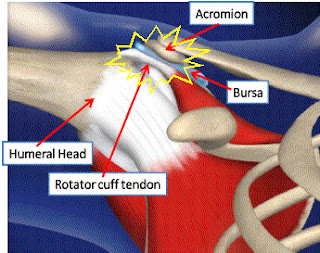Welcome back!
Firstly, I want to congratulate all the Individuals and Teams who qualified for this years Crossfit Games in Carson, California! You all deserve your spot and it was awesome watching you get there. Unfortunately, Reebok Crossfit Gold Coast finished outside the top 3 this year but still performed solid and we ended up 5th overall. Watch out 2013 – we will be back!
I am back to work after the weekend and straight away have been confronted with more Crossfitters experiencing shoulder problems. This is probably one of the most frequent areas that I seem to treat.
The shoulder is a complex joint with an enormous amount of available range of movement due to its design. The gleno-humeral joint is a “ball and socket” joint allowing for freedom of movement but is actually quite unstable due to the shallow socket (the labrum). It is the role of the rotator cuff muscles to keep the “ball” (head of the humerus) in the socket and the scapular stabilizers (lower trapezius, serratus anterior, rhomboids) to provide dynamic stability for the shoulder girdle. Normal function of the shoulder needs these factors to work together for smooth movement of the shoulder which is termed “scapulohumeral rhythm”.
Altered scapulohumeral rhythm may predispose athletes towards shoulder injury and may also be evident with injury of the shoulder upon clinical assessment. This change in scapulohumeral rhythm may be due to weakness of the scapular stabilizers and/or tightness of the rotator cuff muscles.
Poor posture with rounded shoulders and stiffness through the thoracic spine may also be a factor in leading to injury of the shoulder. Tightness of the pecs, lats, deltoid and upper trapezius will have an effect on the position of the shoulder girdle which can affect smooth functioning of the shoulder.
Shoulder impingement is a commonly diagnosed shoulder impairment that can lead to bursitis, tendinopathy and/or rotator cuff tears and is thought to occur when the rotator cuff tendons are pinched as they pass below bony structures of the scapula. The impingement causes irritation of the rotator cuff tendons, leading to swelling and tendon damage.
Like I have said before, I think Crossfit is great at exposing weaknesses. Poor shoulder mobility, rotator cuff weakness/dysfunction and scapular instability will eventually impact on your ability to train without pain and also your ability to improve on movements such as push press/jerk, shoulder press, pullups, pushups, ring dips, muscle ups, overhead squats and the Olympic lifts.
Most people that I see have weakness of the rotator cuff and scapular stabilizer muscles which can be easily remedied with a simple exercise program called “Bulletproof Shoulders” which was designed by Ben Bergeron of Crossfit New England.
I would recommend starting this routine and performing it 2-3x/week, typically on a active rest day or lighter met-con type day. If you find you cannot get through all the exercise repetitions as prescribed, try breaking it up into smaller sets with the idea you will progress to the full set of reps in time.
If you have persistent shoulder pain then I would advise a visit to your physio. A rotator cuff tear will put you out of action for a minimum of 6 weeks. Rotator cuff surgery will cost you 6-12 months.
So get it fixed ’cause it probably ain’t going to fix itself!

